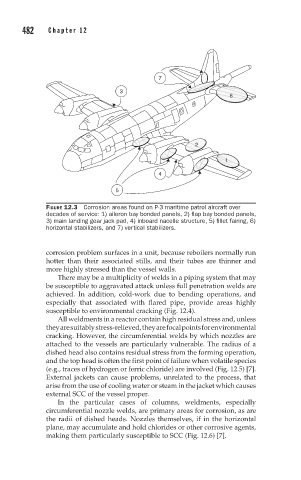Page 515 - Corrosion Engineering Principles and Practice
P. 515
482 C h a p t e r 1 2 C o r r o s i o n a s a R i s k 483
7
3
6
2
1
4
5
FIGURE 12.3 Corrosion areas found on P-3 maritime patrol aircraft over
decades of service: 1) aileron bay bonded panels, 2) flap bay bonded panels,
3) main landing gear jack pad, 4) inboard nacelle structure, 5) fillet fairing, 6)
horizontal stabilizers, and 7) vertical stabilizers.
corrosion problem surfaces in a unit, because reboilers normally run
hotter than their associated stills, and their tubes are thinner and
more highly stressed than the vessel walls.
There may be a multiplicity of welds in a piping system that may
be susceptible to aggravated attack unless full penetration welds are
achieved. In addition, cold-work due to bending operations, and
especially that associated with flared pipe, provide areas highly
susceptible to environmental cracking (Fig. 12.4).
All weldments in a reactor contain high residual stress and, unless
they are suitably stress-relieved, they are focal points for environmental
cracking. However, the circumferential welds by which nozzles are
attached to the vessels are particularly vulnerable. The radius of a
dished head also contains residual stress from the forming operation,
and the top head is often the first point of failure when volatile species
(e.g., traces of hydrogen or ferric chloride) are involved (Fig. 12.5) [7].
External jackets can cause problems, unrelated to the process, that
arise from the use of cooling water or steam in the jacket which causes
external SCC of the vessel proper.
In the particular cases of columns, weldments, especially
circumferential nozzle welds, are primary areas for corrosion, as are
the radii of dished heads. Nozzles themselves, if in the horizontal
plane, may accumulate and hold chlorides or other corrosive agents,
making them particularly susceptible to SCC (Fig. 12.6) [7].

